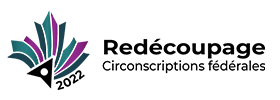Commentaire 191 – commentaires et rétroaction
Les documents ci-dessous sont affichés dans la langue officielle d'origine tels qu'ils ont été reçus.
Retour aux commentaires et rétroaction du public
Benjamin Fisher & Dr. Gayle Broad, Sault Ste. Marie Federal New Democratic Party (NDP) Electoral District Association
See attached.
Written Submission: Electoral Boundaries Commission
October 28, 2022
Presented on behalf of:
Sault Ste. Marie Federal New Democratic Party (NDP) Electoral District Association
Summarized arguments orally presented at Electoral Boundaries Commission Hearing in Timmins, Ontario, October 11, 2022
Orally Presented by:
Benjamin Fisher & Dr. Gayle Broad
Land Acknowledgement:
We hereby acknowledge that we are here in Treaty 9 territory, and that these lands are the traditional territory of Ojibwe/Chippewa, Mushkegowuk (Cree), Algonquin and Métis Peoples.
Further, we acknowledge that the land now known as Sault Ste Marie is situated in Robinson-Huron Treaty territory and the traditional territory of the Anishnaabeg, specifically the Garden River and Batchewana First Nations, as well as the Métis People.
Background of the NDP Riding Association and Presenters:
The Sault Ste. Marie Federal New Democratic Party (NDP) Riding Association has been voicing the concerns of Northern Ontarians for over 60 years. For the periods of 1988-1993 (Steve Butland) and again from 2004 – 2011 (Tony Martin), a New Democrat has been the elected Member of Parliament for Sault Ste. Marie. Hotly contested elections have been the norm for the Sault Ste. Marie riding, with MPs drawn from all three of the dominant Canadian political parties over the past 20 years.
Benjamin (Benn) Fisher is a Graduate Student at the Queen's School of Policy Studies in the Master of Public Administration (MPA) program. Benn proudly represents Northern Ontario and his home community of Sault Ste. Marie. Benjamin is a researcher at the Centre for International and Defence Policy and previously worked with the Canadian Defence and Security Network. He has served as a consultant with international think tanks and associations working toward international peace. Presently, much of his work focusses on policy analysis and the application of constitutional documents in Canadian society. He currently serves on the executive of the New Democratic Party's Electoral District Association of Sault Ste. Marie.
Dr. Gayle Broad is a lifelong resident of the Sault Ste. Marie area and Algoma District. She is Professor Emerita of Algoma University and a Research Associate with NORDIK Institute, a community-based research Institute with a focus on research in Northern Ontario. She is also a former President of the Ontario New Democratic Party.
Transcript of Oral Arguments:
Electoral Boundaries Commission Hearing, Timmins, ON
October 11. 2022
Dr. Gayle Broad
"Thank you Madam Justice
Hello everyone and thank you for having us here today. I am Dr. Gayle Broad, professor emerita from Algoma University, and with me today is Benjamin Fisher a graduate student from Queen's University School of Policy Studies. We are here on behalf of the New Democratic Party of Canada's Electoral District Association of Sault Ste. Marie.
We as settlers are uninvited guests on the land now called Canada and acknowledge that our homes are situated in Robinson-Huron Treaty territory and the traditional territory of the Anishnaabeg and Métis Peoples.
Prefacing our remarks today, I wish to draw attention to significant issues in relying on Census data for population numbers in the North. Dr. David Leadbeater, an economist at Laurentian University, has analyzed census data and come to a number of conclusions. First, Canada Census statisticians themselves acknowledge that the population data related to small communities is inaccurate, and note that data collection in First Nation communities is particularly unreliable. With estimated growth in First Nations at rates of 7% in the 2016-2021 period suggests that the population data across Northern Ontario must be regarded as highly inaccurate at the least. Additionally, Dr. Leadbeater concludes that Northern Ontario, with its long history of extractive, resource-dependent communities has been treated as a colony by senior levels of government, and compressing electoral ridings and reducing its representation will further exacerbate this problem.
I now turn this over to Benn Fisher to make the remainder of the presentation."
Benjamin Fisher
I stand before you today as a young person, passionate and driven to ensure the strength, resilience, and representation of my home of Northern Ontario. Although today, I am here representing the Sault Ste Marie NDP specifically, I hope my voice also reflects, in part, the concerns of my peers across the North in standing up for the future of our home. The grassroots concerns of our community are illustrated through the presentation of evidence-based research. We have conducted this research over a 6-week study of demographic data, consultation with Indigenous members of our electoral district association, the federal New Democratic party, former MPs and MPPs and constituents of Sault Ste Marie.
Our position regarding the proposed boundary changes is 2 parts; first, the current federal riding boundaries across Northern Ontario should remain as is, frozen in their current form, until a proper consultation may be conducted with the Indigenous peoples within the Treaty and traditional lands affected, and an inclusive and extensive census be conducted. Second, we would emphasize that the proposed expansion of the Sault Ste. Marie riding boundaries compromises the capacity of a Member of Parliament to provide necessary and appropriate representation to constituents due to the vast geography and diversity of peoples in the region.
To begin, our position to freeze the current electoral boundaries is grounded in legal precedent. Evidence of this is illustrated in the 2008 Ontario Court of Appeals case Platinex Inc. v. Kitchenuhmaykoosib Inninuwug (KI) First Nation, which cited that proper consultations must occur with Indigenous groups in the province. Certainly, a decision related to ongoing representation in federal-decision making should include formal consultation with Indigenous people. We also note that, as a means of advancing reconciliation, the burden lies with the "honour of the crown" requirement for the federal government to consult Indigenous groups on cultural and social rights grounds. The Constitutional duty to consult with Indigenous peoples within the broader social, political, and economic community over which the Crown is sovereign, is mandated in the Supreme Court's 1997 decision Delagmuukw V. British Columbia.
Therefore, the boundaries must be frozen until the legal requirements of proper consultation are met.
Second, the proposed riding redistribution shall have continued negative effects on annexed constituents and on the capacity of elected representatives to provide adequate service. The proposed expansion of the SSM riding would decrease the representation of constitutionally protected language groups. I.e., Francophones in the surrounding area of SSM. This will ultimately limit the voice of Francophone constituents as their collective identity vote will be limited in its effectiveness compared to its effect in a riding that has a greater body of Francophone constituents.
The proposed boundary changes to the Sault Ste. Marie riding reinforce existing inequities between rural and urban populations and challenge an elected Member's ability to adequately serve constituents.
In a time of reduced government services in the North, MPs in the region are challenged by numerous winter road closures (16 in the 2021-22 winter), no public transit in rural areas and extremely limited air service. These challenges are exacerbated by lack and/or inadequacy of internet services.
Ultimately however the proposed "need" for federal riding redistribution illustrates an inherent and pervasive policy failure from all levels of government. It has been made abundantly clear that population levels in the North have been decreasing on the macro-level for some time. Fuelled by outward-youth migration Northern Ontario has seen a lack of policy solutions that would stimulate local economies and see communities in the North flourish and grow. Personally, I have witnessed first-hand the pressures on young people to search for economic opportunity in other regions of the country. This pervasive policy failure has now resulted in a crossroads where Northern Ontarians, under the proposed redistricting boundaries will see their representation take a steep decline in our federal legislatures.
Therefore, we respectfully request that the Commission reconsider and freeze the representation at current levels until proper consultations can take place and reassess their strict reliance on Census numbers as a determinant of riding boundaries.
Sault Ste. Marie Federal NDP Riding Association Positions:
- That the current federal riding boundaries across Northern Ontario remain as is (frozen in current form) until a proper consultation may be conducted with the Indigenous peoples within the Treaty and traditional lands affected, and an inclusive and extensive census be conducted.
- That the proposed expansion of the Sault Ste. Marie riding boundaries may compromise the capacity of a Member of Parliament to provide necessary and appropriate representation to constituents in the proposed annexation.
1. Supporting Evidence for Freezing Current riding boundaries:
Consistent court decisions have strongly supported Indigenous peoples' rights to be consulted in all decisions related to their lands and territories. This was illustrated in the 2008 Ontario Court of Appeal decision related to the incarceration of the "KI6" in 2008 by the Ontario Court of Appeal which dismissed the province's claim against six members of Kitchenuhmaykoosib Inninuwug (KI) First Nation who objected to the province's refusal to conduct a proper consultation prior to issuing exploration rights to a mining company which infringed on KI territory.
Certainly, a decision related to ongoing representation in decision-making at the federal government that impacts Indigenous peoples requires by law that consultation occurs. Undoubtedly, every riding in Northern Ontario will include Indigenous peoples – First Nations, Inuit and/or Metis.
Court decisions, particularly those at the Appellate level, ought to be sufficient to compel all governments to adhere to both the intent as well as the letter of the law. In case this evidence is not compelling enough, however, we would remind the Electoral Boundaries Commission of the following supporting factors for the above-noted position that no action on boundary changes be taken until a proper consultation can be conducted:
- Ontario is home to 23% of all First Nations in Canada.
- There are 124 First Nations (of 203 province-wide) located in Northern Ontario, with three identified linguistic and cultural traditions
- Historically the region hosts 3 of the most populous sites of Metis peoples. Metis people have proven in the courts that their voice has not been well represented/heard by government – and Sault Ste. Marie has been identified by scholars as one of the earliest Metis settlements in Canada.
- Census data does not purport to accurately reveal the actual numbers of Indigenous peoples due to the small size of many First Nations and acknowledges these inaccuracies. note 1 Further, First Nations and Indigenous populations, generally, are a growing population –
"The total Indigenous population in Northeastern Ontario increased from 41,005 in 2001 to 57,715 in 2011 and to 69,510 in 2016. In other words, share of the Indigenous population in Northeastern Ontario rose from 7.5 per cent in 2001 to 12.9 per cent in 2016. The total Indigenous population in Algoma District increased from 10,800 in 2001 to 15,460 in 2016, a growth rate of approximately 43.2 per cent. The share of the Indigenous population in Algoma District rose from 9.2 per cent to 13.8 per cent between 2001 and 2016, and by over 7% in the 2021 census." note 2 (see Figure 1)
Figure 1
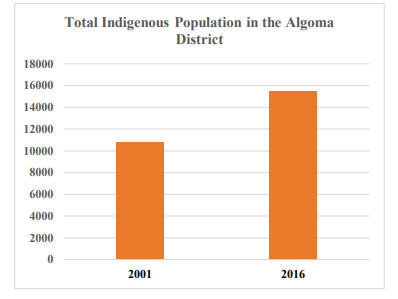
- 15 residential schools were located in Northern Ontario (out of 17 Ontario-wide), leaving many survivors and their families with a legacy of intergenerational trauma, loss of status, and lack of roots in either First Nations or settler communities.
Beyond the Appellate level, Aboriginal rights identified in Section 35 of the Constitution Act, 1982 have been interpreted by the Supreme Court of Canada (SCC) as a means of advancing reconciliation, as well as the importance of consultation in the protection of those rights to reconcile interests. Importantly, the SCC has emphasized that the "Honour of the Crown" may require it to consult Indigenous groups while acting with honour and integrity, and in good faith in the spirit of reconciliation. Section 35 stipulates that Aboriginal rights can include; Aboriginal title (ownership rights to land), rights to occupy and use lands and resources, such as hunting and fishing rights, self-government rights, cultural and social rights. note 3 The SCC has asserted that "distinctive aboriginal societies exist within, and are a part of, a broader social, political and economic community, over which the Crown is sovereign." (Delgamuukw v. British Columbia, 1997) note 4 This, we suggest, emphasizes the need for consultation between the Crown and Indigenous people in the redistribution of Federal electoral boundaries.
2. Potential Impacts on Annexed Constituents:
In addition to the substantial concerns related to Indigenous representation outlined above, the Sault Ste. Marie NDP Riding Association has identified three crucial concerns related to the proposed annexation of a portion of the current Algoma-Manitoulin-Kapuskasing riding including: a less vibrant voice for francophones; substantial and severe impediments to providing service and voice to the annexed rural areas; and the potential for a continuation of the historical 'colonization' of the region resulting in policies contrary to the best interests of Northern, Indigenous and rural regions.
Francophone representation:
"The total Francophone population in Northeastern Ontario declined from 130,085 in 2001 to 114,770 in 2011 but rose to 121,830 in 2016. The total Francophone population in Algoma District declined from 9,260 in 2001 to 7,515 in 2016." note 5 As the charts below indicate, almost one quarter of the Algoma-Manitoulin-Kapuskasing (AMK) riding are francophones (Figure 2), while Sault Ste. Marie (SSM) has only 2.64% francophone residents (Figure 3). These figures are taken from Statistics Canada Census data that illustrates the demographic make-up of the current federal riding boundaries of both the Sault Ste. Marie Riding and the Algoma-Manitoulin-Kapuskasing Riding. It is highly likely that with this type of differential, francophone voters will experience a significant loss in 'vote value' at election time given that the city of Sault Ste. Marie has, by far, the largest overall number of voters, but a very small percentage of francophone voters. This will ultimately limit the voice of Francophone constituents in the proposed Sault Ste. Marie boundaries as their collective identity vote will be limited in its effectiveness compared to its effect in a riding that has a greater collective of Francophone constituents.
Figure 2
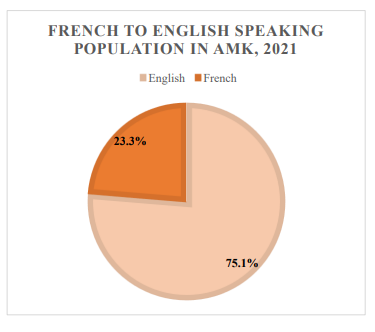
Figure 3
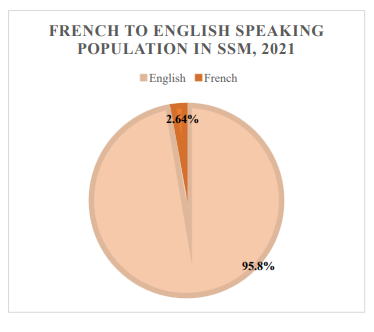
Impediments to Providing Service and Voice:
Ensuring that constituents are well served by government programs and policies, and conveying the impacts of such, as well as constituent concerns back to Ottawa, are the primary responsibilities of Members of Parliament. With government office closures across the North, more and more communities rely (and are even referred to by government departments) on MPs' offices for assistance with everything from EI claims to OAS and CPP applications/problems. The proposed boundary changes to the Sault Ste. Marie riding reinforce some existing impediments and raise some additional challenges for any elected Member including; challenges inherent in serving the huge geographic area encompassed by the proposed new boundaries; lack and/or inadequacy of internet services; and the significantly differing needs of small rural communities versus larger urban centres.
Large geographic area:
The proposed expansion of the Sault Ste. Marie riding will require approximately 18 hrs to drive through by car – in a region which experienced over 16 major road and highway closures due to weather in the 2021-22 winter. Further, even when roads are open, not all areas are accessible by road, and for most communities there is no rail nor air service, and certainly no public transportation system. Driving Northern roads in the winter can be treacherous but lately there have been as many accidents causing road closures throughout the year. Even in the early fall season there were two accidents, one by Goulais River closing the highway in both directions for more than 12 hours and one near Wawa closing the highway. Northern highways have seen many fatal crashes. By expanding the Sault Ste Marie riding many smaller urban communities and small rural communities will be expected to travel great distances to obtain service. Constituents will also have added travel costs to obtain service in a larger centre in this new riding.
Lack of Internet services
The Internet isn't always a viable option in areas of our riding, further disadvantaging folks especially in rural areas. In a 2017 report on Northern broadband infrastructure, Dr. Catherine Middleton recalled the experiences of Northern Ontarians while underscoring the expanding service gaps between urban and rural. One participant in her study emphasized this gap and noted that "kids at local schools? can't conduct "research on the internet" for assignments due to poor internet speeds. note 6 Further, the participant emphasized that the broadband needs of their remote location differ greatly from that of the rest of Ontario. note 7 Most importantly, this participant resides in a community "North of Wawa," Ontario, in a community that would be added to the Sault Ste Marie riding if the proposed boundaries are implemented. note 8 Broadband access is one of many inequities that rural Northern Ontarians face in their day-to-day lives. Residents of urban Sault Ste. Marie centre do not have to contend with connectivity issues to the same extent. As Mandy-Jean Masse writes, "By arming communities with opportunities that are unfettered by eternal download speeds and sprawling geography which place knowledge and opportunity out of reach, high speed broadband services can function as a springboard of opportunity for small, northern communities to expand their horizons, and markets." note 9
The broadband case study emphasizes the two dichotomies that exist between issues impacting rural and urban areas in the proposed Sault Ste. Marie electoral boundaries. It is evident that constituents have illustratively inequitable access services, including broadband. Therefore, it is abundantly clear that the issues that motivate rural constituents to vote may starkly differ from those of urban voters in communities like Sault Ste. Marie. We suggest that discrepancies like this illustrate the need for the Sault Ste. Marie and Algoma Manitoulin ridings to remain the same, to ensure that rural and urban voices have their own representation in the House of Commons.
Figure 2: Map of households underserved by 5Mbs Broadband connections Northeastern Ontario in 2015
Source: http://www.connectednorth.ca/wp-content/uploads/2015/09/dwellings-underserved-northeast-new.jpg
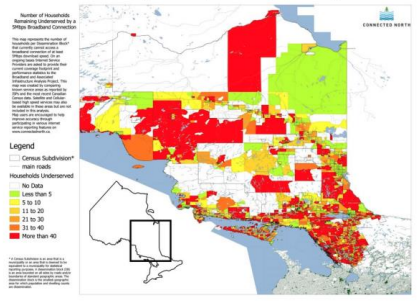
Rural vs. Urban Concerns
Understanding the dichotomy between rural and urban needs emphasizes that a single Member of Parliament could not effectively serve the priorities of their constituents under the proposed riding distribution changes. Northern Ontario is not a "single, resource-dependent, monolithic economy" and requires a "range of solutions" to address community-specific issues "rather than a one-size fits all approach." note 10 Economists and researchers have emphasized that policy solutions for the North need to target the specific assets and challenges of economic clusters across its vast geographic landscape. note 11 Disparities between urban economic clusters and rural communities illustrate the increasing gap in services that both the urban and rural experience across the North. This inherent gap emphasizes why adding swaths of rural communities into a Federal Riding based around an economic urban centre is an ineffective resolution to population and equity issues.
Conclusion
Northern Ontario has historically had significant difficulties in getting its voice heard at a policy level, even with the current 10. Eliminating a riding comprised entirely of relatively small communities will significantly weaken the attention and service it currently receives and will weaken the representation required to strengthen Indigenous and francophone equity in the decisions that most affect them. Therefore, we respectfully request that a) the current electoral boundaries in Northern Ontario be frozen until such time as a thorough consultation with Indigenous peoples be conducted; and further, b) that the concerns raised regarding geographic size, lack of internet service, and rural-urban equity be acknowledged and addressed in any future boundary redistribution proposal.
Bibliography
Cirtwill, Charles, and Emma Helfand-Green. "Northern Perspectives Growth Beyond Cities: Place-Based Rural Policy Development in Ontario." 2017. In Rural Ontario Foresight Papers 2017, compiled by Northern Policy Institute, 26-27. Guelph, ON: Rural Ontario Institute, 2017. https://www.northernpolicy.ca/upload/documents/publications/commentaries-new/cirtwill-helfand-green_northern-perspect.pdf.
Government of Canada. "INAN - Section 35 of the Constitution Act 1982 - Background - Jan 28, 2021." Immigration, Refugees and Citizenship Canada. Last modified January 28, 2011. Accessed October 28, 2022. https://www.canada.ca/en/immigration-refugees-citizenship/corporate/transparency/committees/inan-jan-28-2021/inan-section-35-consitution-act-1982-background-jan-28-2021.html.
Leadbeater, David, Pat Marcuccio, Charlene Faiella, Tomasz Mrozewski, and Caitlyn Richer. "Population, Employment, Social Composition, and Urban Structure in Northern Ontario: Expansion and Decline in a Hinterland-Colonial Region, 1871-2016." Unpublished manuscript, n.d.
Masse, Mandy-Jean. "The Digital Divide: Internet Access in Northern Ontario." Northern Policy Institute. Last modified November 14, 2016. Accessed October 28, 2022. https://www.northernpolicy.ca/article/the-digital-divide-internet-access-in-northern-ontario-26289.asp.
Middleton, Catherine. "Broadband Infrastructure for the Future: Connecting Rural Ontario to the Digital Economy." 2017. In Rural Ontario Foresight Papers 2017, compiled by Northern Policy Institute, 46-67. Guelph, ON: Rural Ontario Institute, 2017. https://www.northernpolicy.ca/upload/documents/publications/commentaries-new/cirtwill-helfand-green_northern-perspect.pdf.
Moazzami, Bahktiar. Northern Projections: Algoma District. Research report no. 978-1-989343318-0. Human Capital Series. Thunder Bay, ON: Northern Policy Institute, 2019. https://www.northernpolicy.ca/upload/documents/publications/reports-new/algoma_20.11.05.en.idd.pdf.
Tossutti, Livianna, Eric Mintz, Kathy Brock, and Doreen Barrie. "Indigenous Rights and Governance." In Canadian Politics Today. North York, ON: Pearson Canada Inc., 2021. CITE.
Footnotes
Return to note 1 David Leadbeater et al., "Population, Employment, Social Composition, and Urban Structure in Northern Ontario: Expansion and Decline in a Hinterland-Colonial Region, 1871-2016" (unpublished manuscript, n.d.).
Dr. David Leadbeater, an economist at Laurentian University in Sudbury, has led extensive research into the inadequacies of census data related to Northern Ontario. This collaborative manuscript, currently under editorial review with expected publication in 2023, reveals significant flaws in data collection methods particularly in smaller communities across Northern Ontario including both rural and First Nations communities.
Return to note 2 Bahktiar Moazzami, Northern Projections: Algoma District, research report no. 978-1-989343-18-0, Human Capital Series (Thunder Bay, ON: Northern Policy Institute, 2019), 14. https://www.northernpolicy.ca/upload/documents/publications/reports-new/algoma_20.11.05.en.idd.pdf.
Return to note 3 Government of Canada, "INAN - Section 35 of the Constitution Act 1982 - Background - Jan 28, 2021," Immigration, Refugees and Citizenship Canada, last modified January 28, 2011, accessed October 28, 2022, https://www.canada.ca/en/immigration-refugees-citizenship/corporate/transparency/committees/inan-jan-28-2021/inan-section-35-consitution-act-1982-background-jan-28-2021.html.
Return to note 4 Livianna Tossutti et al., "Indigenous Rights and Governance," in Canadian Politics Today (North York, ON: Pearson Canada Inc., 2021), CITE.
Return to note 5 Moazzami, Northern Projections, 14.
Return to note 6 Catherine Middleton, "Broadband Infrastructure for the Future: Connecting Rural Ontario to the Digital Economy," 2017, in Rural Ontario Foresight Papers 2017, comp. Northern Policy Institute (Guelph, ON: Rural Ontario Institute, 2017), 48, https://www.northernpolicy.ca/upload/documents/publications/commentaries-new/cirtwill-helfand-green_northern-perspect.pdf.
Return to note 7 Middleton, "Broadband Infrastructure," in Rural Ontario, 48.
Return to note 8 Middleton, "Broadband Infrastructure," in Rural Ontario, 48.
Return to note 9 Mandy-Jean Masse, "The Digital Divide: Internet Access in Northern Ontario," Northern Policy Institute, last modified November 14, 2016, accessed October 28, 2022, https://www.northernpolicy.ca/article/the-digital-divide-internet-access-in-northern-ontario-26289.asp.
Return to note 10 Charles Cirtwill and Emma Helfand-Green, "Northern Perspectives Growth Beyond Cities: Place-Based Rural Policy Development in Ontario," 2017, in Rural Ontario Foresight Papers 2017, comp. Northern Policy Institute (Guelph, ON: Rural Ontario Institute, 2017), 26, https://www.northernpolicy.ca/upload/documents/publications/commentaries-new/cirtwill-helfand-green_northern-perspect.pdf.
Return to note 11 Cirtwill and Helfand-Green, "Northern Perspectives," in Rural Ontario,
